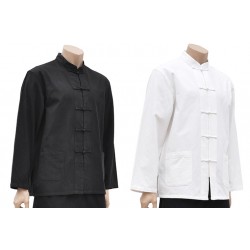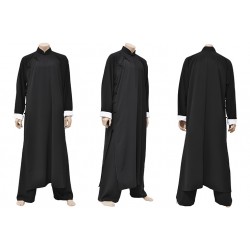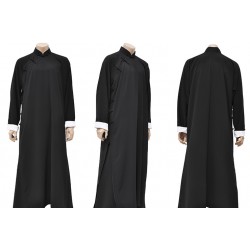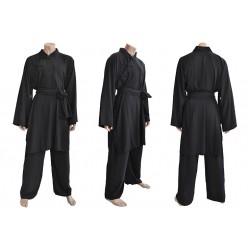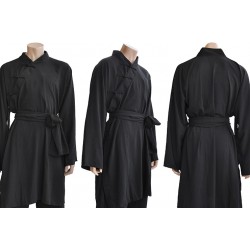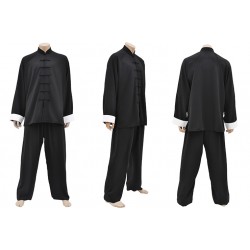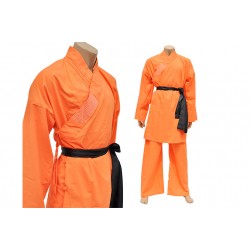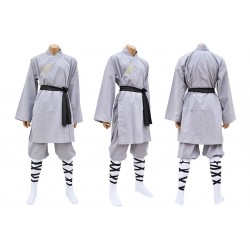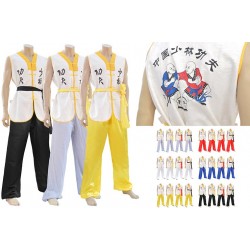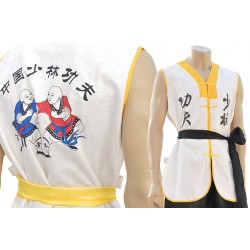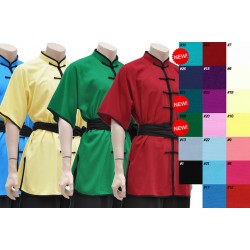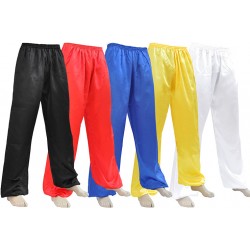Online sale of kung fu suits, clothesKimonos for KUNG FU practice. Complete catalogue of kung fu uniforms at good price.
This catalogue corresponds to a complete kung fu shop, but first we do a historical review of this martial discipline
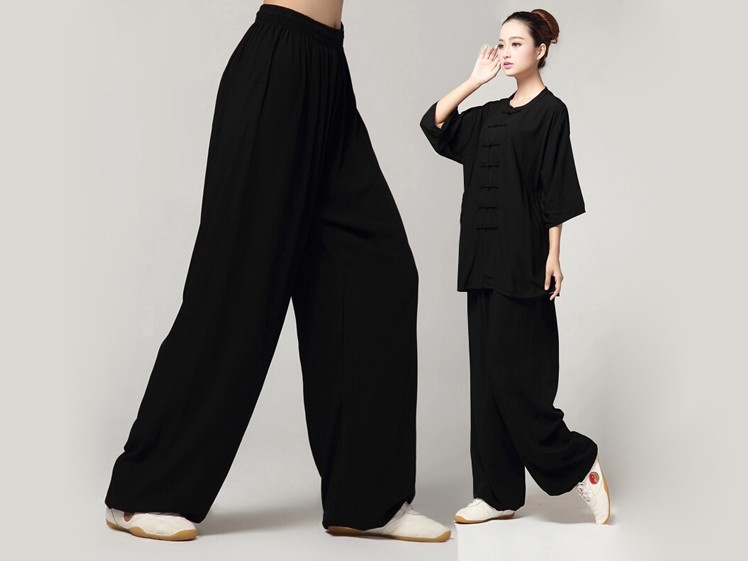
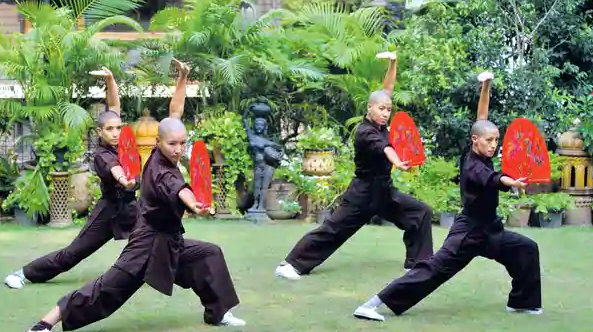
Buy kung fu suits and the origins of this discipline
Let us begin with an explanation of some terms and expressions. The term "kung fu" (or "gung fu") literally means "full through a great effort", but it is also taken as the name of a group of Chinese martial arts that typically present strong blows and kicks. The term "kung" means something like accomplishment or merit, and "fu" can be translated as a man. To practice this discipline the ideal thing is to carry a traditional kung fu suit or kung fu uniform.
Where does Shaolin's kung fu kimono really come from?
A lot of people have the impression that the Kung Fu originated in the Shaolin Temple. He didn't.. Continue reading to learn more details before buying your kung suits online. Although many people believe that Chinese martial arts originated in the Shaolin Temple, there is some evidence that suggests that Chinese martial arts developed long before the Shaolin Temple was built. The temple was built in the 3rd century AD, but there are references to figures like the doctor Hwa Tuo, who used animal movements-based exercises to improve the physical health of their patients long before that date. Hwa Tuo lived in the time of the Three Kingdoms, around 220-65 AD. It is said that Hwa Tuo created a set of exercises based on five animals: tiger, bear, monkey, stork and deer. The reason this is significant is that even today there is a strong relationship between the animal movement and the Chinese martial arts. To make them all smooth, you need a kung fu suit.
Kimono kung fu shaloin
In fact, the Shaolin temple became a centre for the development of martial arts and remained this way for more than a thousand years before it was dissolved by the Ching dynasty in the eighteenth century. To learn more, the Shaolin Temple is at the foot of the "Songshan" mountain in Dengfeng County, Honan Province. It should also be said that many Shaolin temples have been built throughout China. It is not known whether they were established as competitors of the Songshan Temple or whether they represented an extension of the original Shaolin Temple. In any case, with the practice of martial arts in these temples, the use of Shaolin kung fu suits was also extended.
Who was Da Mo (Bodhidharma) and what is the name of this monk's kung fu suit?
In 527 AD, a monk known as Da Mo (Bodhidharma) arrived Shaolin Temple. It is believed that Dat Mo was an Indian monk who was probably born in Kanchipuram, near Madrás. Da Mo traveled to the city of Kuang, now known as Canton, where he was granted an audience with the emperor of the time, Wu Ti of the Liang dynasty. The emperor had instructed local Buddhist monks to translate the Buddhist texts from Sanskrit to Chinese, with the intention that the general population could practice Buddhist religion and wear kung fu suits. After his audience with the Emperor, Dat Mo traveled to a monastery in the Kingdom of Weibefore finally arriving at the temple of Shaolin. When Da Mo first arrived at Shaolin, he was denied entry, perhaps because he was considered a foreigner (he still did not wear his kung fu uniform). Rejected by the monks, Da Mo went to a nearby cave and meditated, looking at the cave wall for nine years, until the monks recognized their religious feats and admitted it. Legend has it that he made a hole on one side of the cave with his constant gaze. Unfortunately, the real reason Da Mo won the recognition of the Shaolin monks has been lost in history. There is also a story that a local monk was so touched by Dat Mo's mercy that he cut off a hand in sympathy. Once admitted to the temple, it is believed that Dat Mo found his Chinese disciples too weak, both physically and mentally, to use kimono kung fu and practice the intensive meditation required by his path to enlightenment. Dat Mo is considered the founder of Chan Buddhism, which is probably best known for its Japanese derivative, Zen Buddhism.
Is there a kung fu suit for kids?
Yeah, sure, we also have the kimono Or the children's kung fu suit. It is basically the same as the adult, but adapted to the measures of a child. Buying it is really an educational alternative for children who begin to be interested in traditional Japanese culture. To keep them in touch with the exciting world of martial arts, which are a disciplined and orderly way of life, there is nothing like giving a child an original kung fu suit.
The Shaolin temple and the kung fu kimono
To overcome the health problem of the monks, Dat Mo devised exercises that combined physical movement and breathing, thus strengthening the body and mind of his disciples. This allowed them. follow the spiritual path with more vigor. Since Dat Mo himself was from the casta guerrera (Ksatriva), some of the exercises may be derived from Indian martial tradition.
It is evident, therefore, that the first suits of Shaolin Kung Fu were largely internal in nature, and were designed for improve health, mind control and perception of Buddha's nature. The content of this training has been reduced to the present as:
Ye Gun Kung: exercises designed to strengthen the physical body by working tendons. A kung fu uniform is used for this discipline.
Sai Choi Kung - The art of cleaning (the body - the mind).
Sime Kung - Meditation practice that incorporates: kimono kung fu, stationary or movement exercises that train the practitioner to feel, improve and finally control the movement of the Chi in his body; and spiritual training, an effort to directly perceive the "Original Face" or the " Buddha's Nature".
What's the name of the kung fu suit?
As strange as it may seem, there is no exact name for the kung fu suit. It has been popularly appointed by teachers and practitioners as a suit for the kung fu, clothes to make kung fu, kimono for kung fu or uniform to practice kung fu or children's kung fu suit (children).
The most accepted version by his Chinese name is probably Gi, which means kimono in Chinese. So, to give it a more traditional name in Chinese, we're probably talking about a kung fu Gi when we want to refer to the suit in a formal way. They can usually be found in a kung fu shop and are black.
People with traditional kung fu suits or kung fu suits for children
The Chinese martial arts, and indeed all the martial arts that followed, seem to be the result of a mix between India and China, and the passage of people with kung fu suits between the two counties. The monks and merchants were constantly traveling and it is not insane to assume that they needed trained guards or even to learn to defend themselves. Combined with Dat Mo's intervention in the Shaolin Temple, this has led to what we call Kung Fu today. Lau Gar is a form of Kung Fu and, as such, would also have its roots in the Shaolin Temple.
What is the price of kimono or kung fu suit?
The kung fu suits are cheap. You'll notice right away, as soon as you take a look at the catalogue we show you. For a kung fu suit the price is usually less than 90 euros. Unless we're talking about a traditional Chinese high suit quality or greater range, the price of kung fu clothing does not exceed the amount mentioned.
There are kung fu clothes and suit for man, kung fu suits for woman, children... Take a look at the catalogue of kung fu suits with delivery to your city or province: Barcelona, Valencia, Madrid, Sevilla, Canary Islands, Balearic Islands, Cadiz, Galicia, Basque Country ... Buy your kung fu suit in Spain.
KUNG FU SUITS There are 49 products.
- 0 Review(s)
TOP CHINESE TRADITIONAL TANGZHUANG BLACK...
T-shirt (upside) traditional Chinese. Origen of the Qing dynasty. Long sleeve. For fans of martial arts and Chinese culture. Color: black or white.
38,43 € - 0 Review(s)
TRADITIONAL KUNG FU AND TAI CHI
Traditional Chinese tunic. It is very large and large so it does not bother to make the movements of kung fu or tai chi. You can select your size below.
106,61 € - 0 Review(s)
TOP OF TRADITIONAL KUNG FU AND TAI CHI TUNIC
Includes only the robe. It doesn't include pants. It is a large garment that allows good freedom of movement when practicing kung fu or tai chi.
90,91 € - 0 Review(s)
TRADITIONAL CHINESE ZHONG SHAN
Traditional Chinese Zhong Shan. For lovers of martial arts and traditional Chinese culture.
82,64 € - 0 Review(s)
TOP OF TRADITIONAL CHINESE TUNIC ZHONG SHAN
Includes the top of the robe. It doesn't include pants. Traditional Chinese breathable fabric and long sleeves.
60,32 € - 0 Review(s)
TRADITIONAL CHINESE ZHONG SHAN FABRIC...
Traditional high-end Chinese fabric made of classic fabric. This Chinese robe is made of elastane (elastic fiber) to provide greater freedom of movement. Black color.
90,08 € - 0 Review(s)
CHINESE COTTON AND ORANGE SHAOLIN SUIT
Shaolin-style uniform. Made of cotton and lyocell. Orange color.
52,02 € - 0 Review(s)
CHINESE SUIT OF COTTON AND GREY SHAOLIN
Authentic shaolin-style costume. Made of cotton and lyocell. Grey color.
52,02 € - 0 Review(s)
CHINESE MONJO LUO BUDDHIST MONK SUIT
Original Chinese uniform of Buddhist monk. Classic costume of Buddha's direct followers.
51,65 € - 0 Review(s)
CHINESE MONJO LUO BUDDHIST MONK SHIRT
Shirt of Buddhist monk “Luohan” without sleeves. With Chinese drawings and characters. Original Chinese Buddhist costume.
30,99 € - 0 Review(s)
TOP / CUSTOM CHINA SHIRT CHANG QUAN...
You can customize your Chang Quan shirt according to the colors you want:- You can choose shirt color.-You can choose color from the edges.-You can choose belt color._
52,89 € - 0 Review(s)
KUNG FU AND TAI CHI TROUSERS MADE OF SATIN
Chinese original trousers for kung fu and tai chi. The size is chosen according to the height of the person. Various colors: black, blue, red or yellow.
26,86 €


